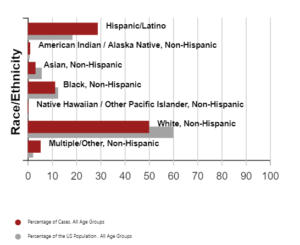The coronavirus has hit minority communities harder in terms of health by amplifying social and economic factors while also revealing deep-rooted inequities. Racial disparities that were present before the pandemic have only been compounded and are evident in the rates of minorities contracting the virus compared with their percentage of the population. This has especially been seen in Latino and multiracial communities in the United States. According to the CDC, Latinos make up 18% of the population and account for nearly 29% of Covid-19 cases. Similarly, those who identify as multiracial (non-Hispanic) make up 2% of the population but 5% of Covid-19 cases.
As a result of the pandemic, racial and ethnic disparities in access to behavior health care have also been illuminated. Interestingly, the rates of behavioral health disorders in Blacks and Latinos do not differ from the general population. Yet, they do have markedly less access to mental health and substance-use treatment services. According to the Substance Abuse and Mental Health Services Administration (SAMHSA), of the 4.8 million African Americans that live with mental health disorders 69.4% of them receive no treatment. Of the 6.9 million Hispanics who live with mental health disorders 67.1% receive no treatment. Both these statistics are alarmingly high when compared with the 56.7% of the overall U.S. population that do not receive treatment for mental illness. Likewise, alarming numbers can be seen in those with substance use disorder. Of the 2.3 million African Americans who have Substance Use Disorder, 88.7% do not receive treatment. Of the 3.3 million Hispanics who have Substance Use Disorder, 89.7% do not receive treatment.
There are already many barriers in place for Blacks and Latinos due to social determinants that only increase the vulnerability of those with mental illness. Black and Latinos have lower access to health care, are found to terminate care prematurely, and receive less culturally responsive care. The opioid pandemic is perhaps hitting the Black and Latinos the hardest due to their limited access to preventive treatment and recovery resources for substance use disorders. Despite Blacks having comparable rates of opioid misuse as the general U.S. population, they were found to have the greatest rate of overdose methadone synthetic opioid deaths.
Nurses must work with the health care team to prevent the interruption of substance use treatment and recovery services. Telehealth services must be expanded. Those with substance use disorders and mental illness who have Covid-19 particularly need support during this time. Recovery support groups that have been stopped, clinics that have closed, and the discontinuing of harm reduction services like syringe service programs have the potential to trigger relapses in our patients as well as increase the rates of HIV and hepatitis. According to SAMHSA, Blacks and Latinos who have substance use disorders and mental health disorders are found to be more likely to be homeless and incarcerated which further increases their risk of Covid-19.
There is much potential for managing this identified risk and problem in Black and Latino populations. Policy efforts can be made in the form of disaggregating data so that resources can be targeted based on more specific data. Policies and treatments should be more flexible. For example, SAMHSA released a guide which enabled dispensable take-home methadone treatment programs during the pandemic. There should also be a push for expanded and flexible coverage of telehealth so patients can continue to receive treatment via the telephone or video-conferencing.
Communication, health literacy, and public awareness must also be accounted for. Covid-19 education should be translated into the language of those in the communities we serve. Also, messages should be culturally tailored so that concepts presented like social distancing are culturally appropriate. Communication channels are also important so perhaps using Black and Latino radio stations, websites, and trusted media figures to deliver important messages about prevention strategies
Workforce efforts can also be had by augmenting the workforce with culturally competent healthcare professionals. The workforce is in dire need of the individuals. Perhaps fast-tracking immigrants, refugees, and bilingual health care professionals could create a much needed pool of such health care workers in the United States. Peer navigators and coaches are also valuable for creating outreach and engagement of Black and Latino communities so that they can be properly linked with mental and substance use disorder treatment. Peer navigators know the communities we serve well and know how to effectively communicate with clients. These could be made virtual to ensure Black and Latino communities receive proper behavioral health care.
Blacks’ and Latinos’ physical health have greatly been impacted by the pandemic with a disproportionate rate of Covid-19 infection. However, the pandemic is not only affecting the nation physically—but also behaviorally. As nurses we address the physical and emotional health of our clients because we see them as a whole being. Therefore, we must work hard to address these issues and advocate for our patients so that they can live healthy lives, not just in their bodies—but in their minds as well.
- Addressing the Minds and Bodies of Minorities: How the Covid-19 Pandemic Has Compounded Behavioral Health Issues - May 21, 2021
- Taking a Look at Covid-19 Vaccine Research Minority Representation—Key to Increasing Minority Vaccination - May 13, 2021
- Black Men and the Dilemma of Wearing Masks During the COVID-19 Pandemic - August 18, 2020




